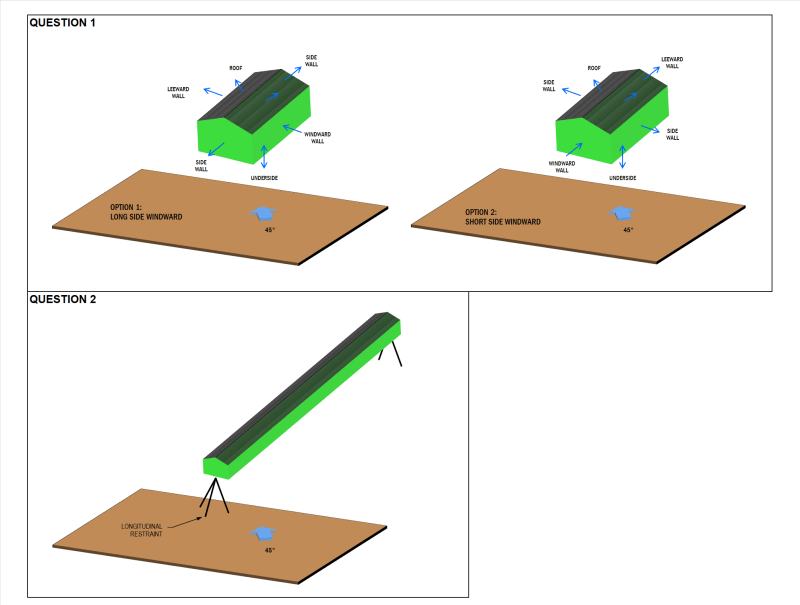Questions relate to an elevated structure, but also apply to structure on ground.
Question 1
Is my understanding correct that for wind at 45°, the pressure coefficients on a building, for design purposes, are the same as that for the wind at 0° or 90°.
BS EN 1991-1-4 says the following in Section 7.2.1 (2):
The values [cpe] in Tables 7.1 to 7.5 should be used for the orthogonal wind directions 0°, 90°, 180°. These values represent the most unfavourable values obtained in a range of wind direction θ = ± 45° either side of the relevant orthogonal direction.
Question 2
If you have a building type structure which is much longer than wider/taller, if the above method is used, the load in the longitudinal direction would be underestimated I believe.
For Option 1 (long side windward), the pressure is normal only, windward and leeward pressure are normal, side wall pressures cancel out. No net load in longitudinal direction.
For Option 2 (short side windward), the windward and leeward walls are relatively small and net pressure in the longitudinal directions would seem low to me.
If the structure was solid, I presume the pressure is applied to the projected area, so for wind at 45°, load in the longitudinal direction would be 0.5 times the load for transverse wind (1/√2 pressure x 1/√2 area = 0.5 Force).
Similarly if the structure consisted of individual members, such as for an open truss.
Question is asked because there will be compression induced in the structure, and the support needs to take longitudinal load back to ground.
Has anyone seen any prescription in codes or technical papers.

Question 1
Is my understanding correct that for wind at 45°, the pressure coefficients on a building, for design purposes, are the same as that for the wind at 0° or 90°.
BS EN 1991-1-4 says the following in Section 7.2.1 (2):
The values [cpe] in Tables 7.1 to 7.5 should be used for the orthogonal wind directions 0°, 90°, 180°. These values represent the most unfavourable values obtained in a range of wind direction θ = ± 45° either side of the relevant orthogonal direction.
Question 2
If you have a building type structure which is much longer than wider/taller, if the above method is used, the load in the longitudinal direction would be underestimated I believe.
For Option 1 (long side windward), the pressure is normal only, windward and leeward pressure are normal, side wall pressures cancel out. No net load in longitudinal direction.
For Option 2 (short side windward), the windward and leeward walls are relatively small and net pressure in the longitudinal directions would seem low to me.
If the structure was solid, I presume the pressure is applied to the projected area, so for wind at 45°, load in the longitudinal direction would be 0.5 times the load for transverse wind (1/√2 pressure x 1/√2 area = 0.5 Force).
Similarly if the structure consisted of individual members, such as for an open truss.
Question is asked because there will be compression induced in the structure, and the support needs to take longitudinal load back to ground.
Has anyone seen any prescription in codes or technical papers.

